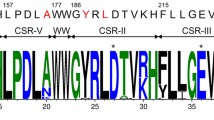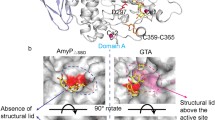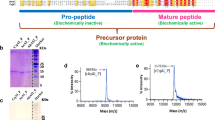Abstract
Most starch hydrolases and related enzymes belong to the α-amylase family which contains a characteristic catalytic (β/α)8-barrel domain. Currently known primary structures that have sequence similarities represent 18 different specificities, including starch branching enzyme. Crystal structures have been reported in three of these enzyme classes: the α-amylases, the cyclodextrin glucanotransferases, and the oligo-1,6-glucosidases. Throughout the α-amylase family, only eight amino acid residues are invariant, seven at the active site and a glycine in a short turn. However, comparison of three-dimensional models with a multiple sequence alignment suggests that the diversity in specificity arises by variation in substrate binding at the β→α loops. Designed mutations thus have enhanced transferase activity and altered the oligosaccharide product patterns of α-amylases, changed the distribution of α-, β- and γ-cyclodextrin production by cyclodextrin glucanotransferases, and shifted the relative α-1,4:α-1,6 dual-bond specificity of neopullulanase. Barley α-amylase isozyme hybrids and Bacillus α-amylases demonstrate the impact of a small domain B protruding from the (β/α)8-scaffold on the function and stability. Prospects for rational engineering in this family include important members of plant origin, such as α-amylase, starch branching and debranching enzymes, and amylomaltase.
Similar content being viewed by others
Abbreviations
- CGTase:
-
cyclodextrin glucanotransferase
- SBD:
-
starch binding domain
- TAA:
-
taka-amylase A
- TIM:
-
triose-phosphate isomerase. The mutations are described with the one-letter code, i.e. D164A is a mutant in which A in the mutant is substituted for D in the wild-type.
References
Ajandouz EH, Abe J, Svensson B, Marchis-Mouren G: Barley malt α-amylase. Purification, action pattern, and subsite mapping of isozyme 1 and two members of the isozyme 2 subfamily using p-nitrophenylated maltooligosaccharide substrates. Biochim Biophys Acta 1159: 193–202 (1992).
Aleshin A, Golubev A, Firsov LM, Honzatko RB: Crystal structure of glucoamylase from Aspergillus awamori var. X100 to 2.2 Å-resolution. J Biol Chem 267: 19291–19298 (1992).
Bork P, Doolittle RF: Proposed aquisition of an animal protein domain by bacteria. Proc Natl Acad Sci USA 89: 8990–8994 (1992).
Baulcombe DC, Hutly AK, Martienssen RA, Barker RF, Jarvis MG: A novel wheat α-amylase gene (α-Amy3). Mol Gen Genet 209: 33–40 (1987).
Belshaw NJ, Williamson G: Specificity of the binding domain of glucoamylase I. Eur J Biochem 211: 717–724 (1993).
Boel E, Brady L, Brzozowski AM, Derewenda Z, Dodson GG, Jensen VJ, Petersen SB, Swift H, Thim L, Woldike HF: Calcium binding in α-amylases: an x-ray diffraction study at 2.1-Å resolution of two enzymes from Aspergillus. Biochemistry 29: 6244–6249 (1990).
Buisson G, Duée E, Haser R, Payan F: Three dimensional structure of porcine pancreatic α-amylase at 2.9 Å resolution. Role of calcium in structure and activity. EMBO J 6: 3909–3916 (1987).
Declerck N, Joyet P, Gaillardin C, Masson JM: Use of Amber suppressors to investigate the thermostability of Bacillus licheniformis α-amylase. Amino acid replacements at 6 histidine residues reveal a critical poistion at His-133. J Biol Chem 265: 15481–15488 (1990).
Farber GK: An α/β-barrel full of evolutionary trouble. Curr Opin Struct Biol 3: 409–412 (1993).
Farber GK, Petsko GA: The evolution of α/β barrel enzymes. Trends Biochem Sci 15: 228–234 (1990).
Fujiwara S, Kakihara H, Woo KB, Lejeune A, Kanemoto M, Sakaguchi K, Imanaka T: Cyclization characteristics of cyclodextrin glucanotransferase are conferred by the NH2-terminal region of the enzyme. Appl Environ Microbiol 58: 4016–4025 (1992).
Fujiwara S, Kakihara H, Sakaguchi K, Imanaka T: Analysis of mutations in cyclodextrin glucanotransferase from Bacillus stearothermophilus which affect cyclization characteristics and thermostability. J Bact 174: 7478–7481 (1992).
Gibson RM, Svensson B: Identification of tryptophanyl residues involved in binding of carbohydrate ligands to barley α-amylase 2. Carlsberg Res Commun 52: 373–379 (1987).
Guan HP, Preiss J: Differentiation of the properties of the branching isozymes from maize (Zea mays). Plant Physiol 102: 1269–1273 (1993).
Harris EMS, Aleshin AE, Firsov LM, Honzatko RB: Refined structure for the complex of 1-deoxynojirimycin with glucoamylase from Aspergillus awamori var. X100 to 2.4-Å resolution. Biochemistry 32: 1618–1626 (1993).
Hermans MMP, Kroos MA, van Beumen J, Oostra BA, Reuser AJJ: Human lysosomal α-glucosidase. Characterization of the catalytic site. J Biol Chem 266: 13507–13512 (1991).
Holm L, Koivula AK, Lehtovaara PM, Hemminki A, Knowles JKC: Random mutagenesis used to probe the structure and function of Bacillus stearothermophilus alpha-amylase. Protein Engng 3: 181–191 (1990).
Hu NT, Hung MN, Huang AM, Tsai HF, Yang BY, Chow TY, Tseng YH: Molecular cloning, characterization and nucleotide sequence of the gene for secreted α-amylase from Xanthomonas campestris pv. campestris. J Gen Microbiol 138: 1647–1655 (1992).
Huang N, Stebbins GL, Rodriguez RL: Classification and evolution of α-amylase genes in plants. Proc Natl Acad Sci USA 89: 7526–7530 (1992).
Huang N, Sutliff TD, Litts JC, Rodriguez RL: Classification and characterization of the rice α-amylase multigene family. Plant Mol Biol 14: 665–668 (1990).
Hunziker W, Spiess M, Semenza G, Lodish HF: The sucrase-isomaltase complex: Structure, membrane-orientation, and evolution of a stalked, intrinsic brush border protein. Cell 46: 227–234 (1986).
Ishikawa K, Matsui I, Honda K, Nakatani H: Multifunctional roles of a histidine residue in human pancreatic α-amylase. Biochem Biophys Res Commun 183: 286–291 (1992).
Ishikawa K, Matsui I, Kobayashi S, Nakatani H, Honda K: Substrate recognition at the binding site in mammalian pancreatic α-amylases. Biochemistry 32: 6259–6265 (1993).
Itoh T, Yamashita I, Fukui S: Nucleotide sequence of the α-amylase gene (ALP1) in the yeast Saccharomycopsis fibuligera. FEBS Lett 219: 339–342 (1987).
Janacek S: New conserved amino acid region of α-amylases in the third loop of their (β/α)8-barrel domains. Biochem J 288: 1069–1070 (1992).
Jespersen HM, MacGregor EA, Henrissat B, Sierks MR, Svensson B: Starch- and glycogen-debranching and branching enzymes. Prediction of structural features of the catalytic (β/α)8-barrel domain and evolutionary relationship to other amylolytic enzymes. J Prot Chem, in press.
Jespersen HM, MacGregor EA, Sierks MR, Svensson B: Comparison of the domain-level organization of starch hydrolases and related enzymes. Biochem J 280: 51–55 (1991).
Joyet P, Declerck N, Gaillardin C: Hyperthermostable variants of a highly thermostable alpha-amylase. Biol/technology 10: 1579–1583 (1992).
Juge N, Søgaard M, Chaix JC, Martin-Eauclaire MF, Svensson B, Marchis-Mouren G, Guo XJ: Comparison of barley malt α-amylase isozymes 1 and 2: construction of cDNA hybrids by in vivo recombination and their expression in yeast. Gene 130: 159–166 (1993).
Kadziola A, Søgaard M, Svensson B, Haser R:: Structure of an α-amylase/inhibitor complex and implications for starch binding and catalysis. Proc Natl Acad Sci USA, submitted.
Kizaki H, Hata Y, Watanabe K, Katsube K, Suzuki Y: Polypeptide folding of Bacillus cereus ATCC7064 oligo-1,6-glucosidase revealed by 3.0 Å resolution x-ray analysis. J Biochem (Tokyo) 113: 646–649 (1993).
Klein C, Hollender J, Bender H, Schulz GE: Catalytic center of cyclodextrin glycosyltransferase derived from x-ray structure analysis combined with site-directed mutagenesis. Biochemistry 31: 8740–8746 (1992).
Klein C, Schulz GE: Structure of cyclodextrin glycosyltransferase refined at 2.0 Å resolution. J Mol Biol 217: 737–750 (1990).
Koizuka N, Tanaka Y, Morohashi Y: Isolation of a cDNA clone for α-amylase in mung bean cotyledons. Plant Physiol 94: 1488–1491 (1990).
Konishi H, Sato T, Yamagata H, Udaka S: Efficient production of human alpha-amylase by a Bacillus brevis mutant. Appl Microbiol Biotechnol 34: 297–302 (1990).
Kubota M, Matsuura, Sakai S, Katsube Y: Molecular structure of B. sterarothermophilus cyclodextrin glucanotransferase and analysis of substrate binding site. Denpun Kagaku 38: 141–146 (1991).
Kuriki T, Takata H, Okada S, Imanaka T: Analysis of the active center of Bacillus stearothermophilus neopullulanase. J Bact 173: 6147–6152 (1991).
Kuriki T, Yanase M, Takata H, Imanaka T, Okada S: Highly branched oligosaccharides produced by the transglycosylation reaction of neopullulanase. J Ferment Bioeng 76: 184–190 (1993).
Lacks SA, Dunn JJ, Greenberg B: Identification of base mismatches recognized by the heteroduplex-DNA-repair system of Streptococcus pneumoniae. Cell 31: 327–336 (1982).
MacGregor EA: α-amylase structure and activity. J Prot Chem 7: 399–415 (1988).
MacGregor EA: Relationships between structure and activity in the α-amylase family of starch-metabolising enzymes. Starch 45: 232–237 (1993).
MacGregor AW, Morgan JE, MacGregor EA: The action of germinated barley α-amylases on linear maltodextrins. Carbohydr Res 227: 301–313 (1992).
MacGregor EA, Svensson B: A super-secondary structure predicted to be common to several α-1,4-d-glucan-cleaving enzymes. Biochem J 259: 145–152 (1989).
Mathupala SP, Lowe SE, Podkovyrov SM, Zeikus JG: Sequencing of the amylopullulanase (apu) gene of Thermoanaerobacter ethanolicus 39E, and identification of the active site by site-directed mutagenesis. J Biol Chem 268: 16332–16344 (1993).
Matsui I, Ishikawa K, Miyari S, Fukui S, Honda K: An increase in the transglycosylation activity of Saccharomycopsis α-amylase altered by site-directed mutagenesis. Biochim Biophys Acta 1077: 416–419 (1991).
Matsui I, Ishikawa K, Miyari S, Fukui S, Honda K: Alteration of bond-cleavage pattern in the hydrolysis catalyzed by Saccharomycopsis α-amylase altered by sitedirected mutagenesis. Biochemistry 31: 5232–5236 (1992).
Matsui I, Ishikawa K, Miyari S, Fukui S, Honda K: A mutant α-amylase with enhanced activity specific for short substrates. FEBS Lett 310: 216–218 (1992).
Matsui I, Yoneda S, Ishikawa K, Miyari S, Fukui S, Umeyama H, Honda K: Roles of the aromatic residues conserved in the active center of Saccharomycopsis α-amylase for transglycosylation and hydrolysis activities. Biochemistry, in press.
Matsuura Y, Kusunoki M, Harada W, Kakudo M: Structure and possible catalytic residues of Taka amylase. J Biochem (Tokyo) 95: 695–702 (1984).
Mikami B, Hehre ED, Sato M, Katsube Y, Hirose M, Morita Y, Sacchettini JC: The 2.0-Å resolution structure of soybean β-amylase complexed with α-cyclodextrin. Biochemistry 32: 6836–6845 (1993).
Mizuno K, Kawasaki T, Shimada H, Satoh H, Kobayashi E, Okumura S, Aral Y, Baba T: Alteration of the structural properties of starch components by the lack of an isoform of starch branching isozyme in rice seeds. J Biol Chem 268: 19084–19091 (1993).
Mizuno K, Kimura K, Arai Y, Kawasaki T, Shimada H, Baba T: Starch branching enzymes from immature rice seeds. J Biochem (Tokyo) 112: 643–651 (1992).
Nagashima T, Toda S, Kitamoto K, Gomi K, Kumagai C, Toda H: Site-directed mutagenesis of the catalytic active-site residues of Taka-amylase A. Biosci Biotech Biochem 56: 207–210 (1992).
Naim HY, Niermann T, Kleinhaus U, Hollenberg CP, Strasser AWM: Striking structural and functional similarities suggest that intestinal sucrase-isomaltase, human lysosomal α-glucosidase and Schwanniomyces occidentalis glucoamylase are derived from a common ancestral gene. FEBS Lett 294: 109–112 (1991).
Nakamura A, Haga K, Ogawa S, Kuwano K, Kimura K, Yamane K: Functional relationships between cyclodextrin glucanotransferase from an alkalophilic Bacillus and α-amylases. Site-directed mutagenesis of the conserved two Asp and one Glu residues. FEBS Lett 296: 37–40 (1992).
Nakamura A, Haga K, Yamane K: Three histidine residues in the active center of cyclodextrin glucanotransferase from alkalophilic Bacillus sp. 1011: effects of the replacement on pH dependence and transition-state stabilization. Biochemistry 32: 6624–6631 (1993).
Oguma T, Matsuyama A, Kikuchi M, Nakano E: Cloning and sequence analysis of the cyclomaltodextrinase gene from Bacillus sphaericus and expression in Escherichia coli cells. Appl Microbiol Biotechnol 39: 197–203 (1993).
Pen J, Molendijk L, Quax WJ, Sijmons PC, van Ooyen AJJ, van den Elzen PJM, Rietveld K, Hoekema A: Production of active Bacillus licheniformis alpha-amylase in tobacco and its application in starch liquefaction. Bio/technology 10: 2293–296 (1992).
Pen J, van Ooyen AJJ, van den Elzen PJM, Rietveld K, Hoekema A: Direct screening for high-level expression of an induced α-amylase gene in plants. Plant Mol Biol 18: 1133–1139 (1992).
Podkovyrov SM, Burdette D, Zeikus JG: Analysis of the catalytic center of cyclomaltodextrinase from Thermoanaerobacter ethanolicus 39E. FEBS Lett 317: 259–262 (1993).
Podkovyrov SM, Zeikus JG: Structure of the gene encoding cyclomaltodextrinase from Clostridium thermohydrosulfuricum 39E and characterization of the enzyme purified from Escherichia coli. J Bact 174: 5400–5405 (1992).
Poulsen P, Kreiberg JD: Starch branching enzyme cDNA from Solanum tuberosum. Plant Physiol 102: 1053–1054 (1993).
Qian M, Haser R, Payan F: Structure and molecular model refinement of pig pancreatic α-amylase at 2.1 Å resolution. J Mol Biol 231: 785–799 (1993).
Rademacher TW, Parekh RB, Dwek RA: Glycobiology. Annu Rev Biochem 57: 785–838 (1988).
Rodenburg KW, Juge N, Guo XJ, Søgaard M, Chaix JC, Svensson B: Domain B protruding at the third β-strand of the α/β-barrel in barley α-amylase confers distinct isozyme-specific properties. Eur J Biochem, accepted for publication.
Schneider E, Freundlieb S, Tapio S, Boos W: Molecular characterization of the MalT-dependent periplasmic α-amylase of Escherichia coli encoded by malS. J Biol Chem 267: 5148–5154 (1992).
Shewmaker CK, Stalker DM: Modifying starch biosynthesis with transgenes in potatoes. Plant Physiol 100: 1083–1086 (1992).
Stark DM, Timmerman KP, Barry GF, Preiss J, Kishore GM: Regulation of the amount of starch in plant tissues by ADP glucose pyruphosphorylase. Science 258: 287–292 (1992).
Suzuki Y, Ito N, Yuuku T, Yamagata H, Udaka S: Amino acid stabilizing a Bacillus α-amylase against irreversible thermoinactivation. J Biol Chem 264: 18933–18938 (1989).
Svensson B: Regional distant sequence homology between amylases, α-glucosidases and transglucanosylases. FEBS Lett 230: 72–76 (1988).
Svensson B, Jespersen HM, Sierks MR, MacGregor EA: Sequence homology between putative raw-starch binding domains from different starch-degrading enzymes. Biochem J 264: 309–311 (1989).
Svensson B, Larsen K, Svendsen I, Boel E: The complete amino acid sequence of the glycoprotein, glucoamylase G1 from Aspergilus niger. Carlsberg Res Commun 48: 529–543 (1983).
Svensson B, Søgaard M: Protein engineering of amylases. Biochem Soc Trans 20: 34–42 (1992).
Svensson B, Søgaard M: Mutational analysis of glycosylase function. J Biotechnol 29: 1–37 (1993).
Søgaard M, Andersen JS, Roepstorff P, Svensson B: Electrospray mass spectrometry characterization of post-translational modifications of barley α-amylase 1 produced in yeast. Bio/technology 11: 1162–1165 (1993).
Søgaard M, Kadziola A, Haser R, Svensson B: Sitedirected mutagenesis of histidine 93, aspartic acid 180, glutamic acid 205, histidine 290, and aspartic acid 291 at the active site and tryptophan 279 at the raw starch binding site in barley amylase 1. J Biol Chem 268: 22480–22484 (1993).
Takaha T, Yanase M, Okada S, Smith SM: Disproportionating enzyme (4-α-glucanotransferase; EC 2.4.1.25) of potato. J Biol Chem 268: 1391–1396 (1993).
Takase K: Interaction of catalytic-site mutants of Bacillus subtilis α-amylase with substrates and acarbose. Biochim Biophys Acta 1122: 278–282 (1992).
Takase K: Effect of mutation of an amino acid residue near the catalytic site on the activity of Bacillus stearothermophilus α-amylase. Eur J Biochem 211: 899–902 (1993).
Takase K, Matsumoto T, Mizuno H, Yamane K: Sitedirected mutagenesis of active site residues in Bacillus subtilis α-amylase. Biochim Biophys Acta 1120: 281–288 (1992).
Takata H, Kuriki T, Okada S, Takesada Y, Iizuka M, Minamiura N, Imanaka T: Action of neopullulanase. Neopullulanase catalyzes both hydrolysis and transglycosylation at α-(1→4)- and α-(1→6)-glucosidic linkages. J Biol Chem 267: 18447–18452 (1992).
Tao BY, Reilly PJ, Robyt JF: Detection of a covalent intermediate in the mechanism of action of porcine pancreatic α-amylase by using 13C nuclear magnetic resonance. Biochim Biophys Acta 995: 214–220 (1989).
Tomasic SJ, Klibanov AM: Mechanisms of irreversible thermal inactivation of Bacillus α-amylases. J Biol Chem 263: 3086–3091 (1988).
Tomasic SJ, Klibanov AM: Why is one Bacillus α-amylase more resistant against irreversible thermoinactivation than another. J Biol Chem 263: 3092–3096 (1988).
Tonozuka T, Ohtsuka M, Mogi S, Sakai H, Ohta T, Sakano Y: A neopullulanase-type α-amylase gene from Thermoactinomyces vulgaris R-47. Biosci Biotech Biochem 57: 395–401 (1993).
Tsukamoto A, Kimura K, Ishii Y, Takano T, Yamane Y: Nucleotide sequence of the maltohexaose-producing amylase gene from an alkalophilic Bacillus sp. # 707 and structural similarity to liquefying type α-amylases. Biochem Biophys Res Commun 151: 25–31 (1988).
Vihinen M, Ollikka P, Niskanen J, Meyer P, Suominen I, Karp M, Holm L, Knowles J, Mäntsälä P: Site-directed mutagenesis of a thermostable α-amylase from Bacillus stearothermophilus: putative role of three conserved residues. J Biochem (Tokyo) 107: 267–272 (1990).
Author information
Authors and Affiliations
Rights and permissions
About this article
Cite this article
Svensson, B. Protein engineering in the α-amylase family: catalytic mechanism, substrate specificity, and stability. Plant Mol Biol 25, 141–157 (1994). https://doi.org/10.1007/BF00023233
Accepted:
Issue Date:
DOI: https://doi.org/10.1007/BF00023233




